Research on Ubiquitous Media in Business Organizations: A Report
VerifiedAdded on 2020/03/16
|13
|2632
|33
Report
AI Summary
This report delves into the use of ubiquitous media within business organizations, examining its concept, potential implementation, and associated theoretical frameworks. The project objectives include determining the concept and usage of ubiquitous media systems, discussing its implementation potential, exploring theoretical frameworks, and analyzing its advantages and disadvantages. The research employs both qualitative and quantitative methodologies, including literature reviews, questionnaires, and data analysis. It addresses research questions regarding the potential of ubiquitous surveillance and its impact on business practices. The report also acknowledges research limitations, such as resource constraints and privacy concerns, and provides a detailed time schedule for the research process. The conclusion summarizes the findings, highlighting the innovative nature of ubiquitous monitoring, its potential benefits, and associated risks, emphasizing the importance of appropriate implementation strategies.
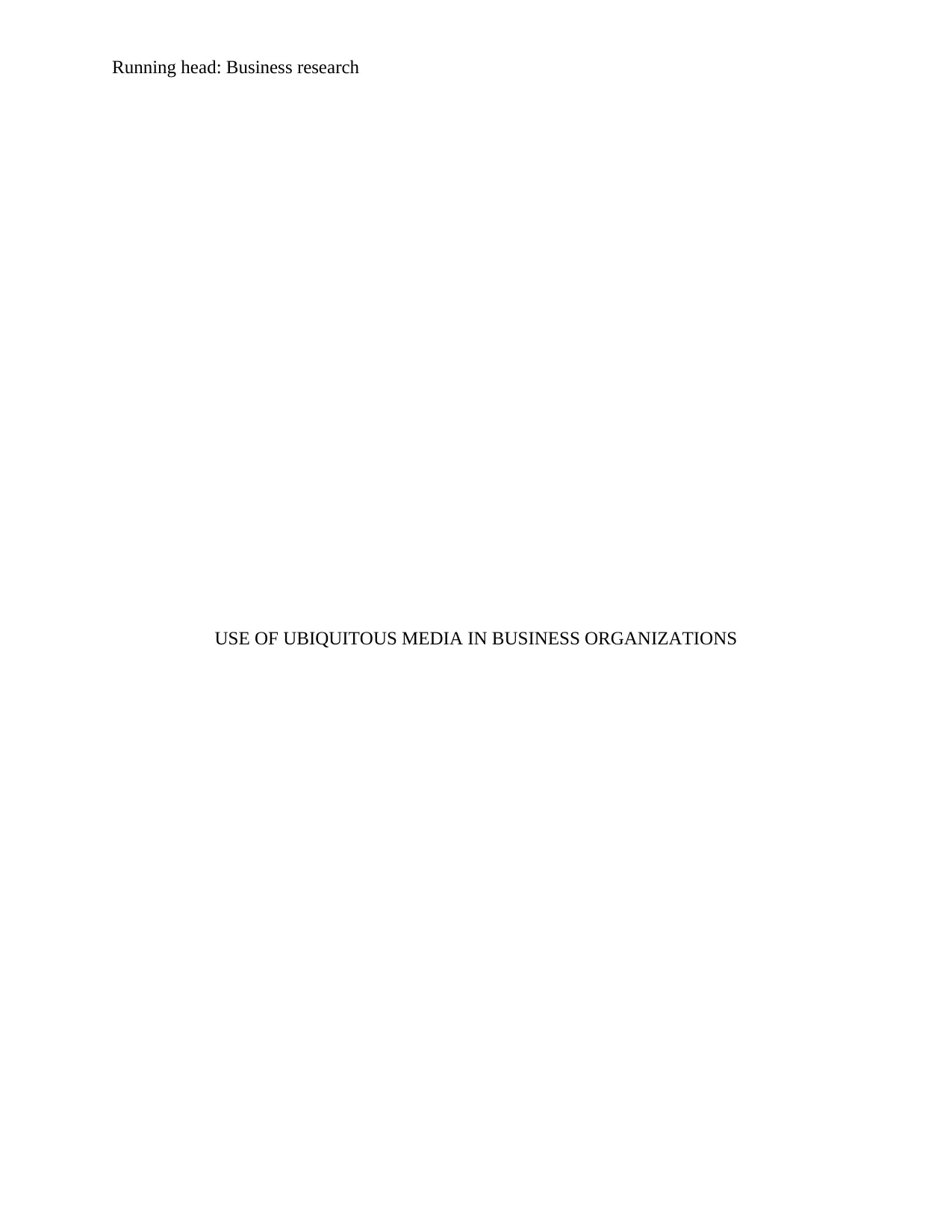
Running head: Business research
USE OF UBIQUITOUS MEDIA IN BUSINESS ORGANIZATIONS
USE OF UBIQUITOUS MEDIA IN BUSINESS ORGANIZATIONS
Paraphrase This Document
Need a fresh take? Get an instant paraphrase of this document with our AI Paraphraser
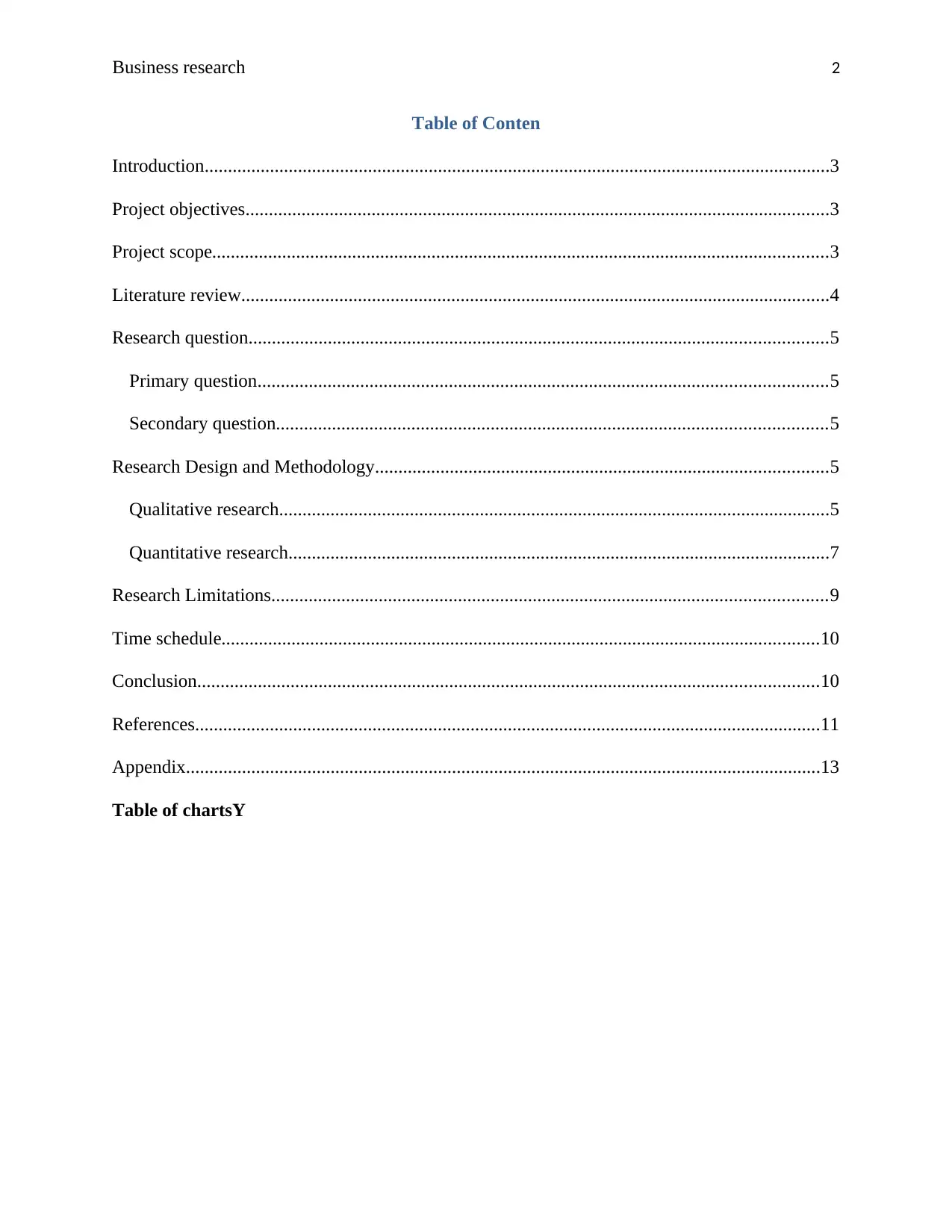
Business research 2
Table of Conten
Introduction......................................................................................................................................3
Project objectives.............................................................................................................................3
Project scope....................................................................................................................................3
Literature review..............................................................................................................................4
Research question............................................................................................................................5
Primary question..........................................................................................................................5
Secondary question......................................................................................................................5
Research Design and Methodology.................................................................................................5
Qualitative research......................................................................................................................5
Quantitative research....................................................................................................................7
Research Limitations.......................................................................................................................9
Time schedule................................................................................................................................10
Conclusion.....................................................................................................................................10
References......................................................................................................................................11
Appendix........................................................................................................................................13
Table of chartsY
Table of Conten
Introduction......................................................................................................................................3
Project objectives.............................................................................................................................3
Project scope....................................................................................................................................3
Literature review..............................................................................................................................4
Research question............................................................................................................................5
Primary question..........................................................................................................................5
Secondary question......................................................................................................................5
Research Design and Methodology.................................................................................................5
Qualitative research......................................................................................................................5
Quantitative research....................................................................................................................7
Research Limitations.......................................................................................................................9
Time schedule................................................................................................................................10
Conclusion.....................................................................................................................................10
References......................................................................................................................................11
Appendix........................................................................................................................................13
Table of chartsY
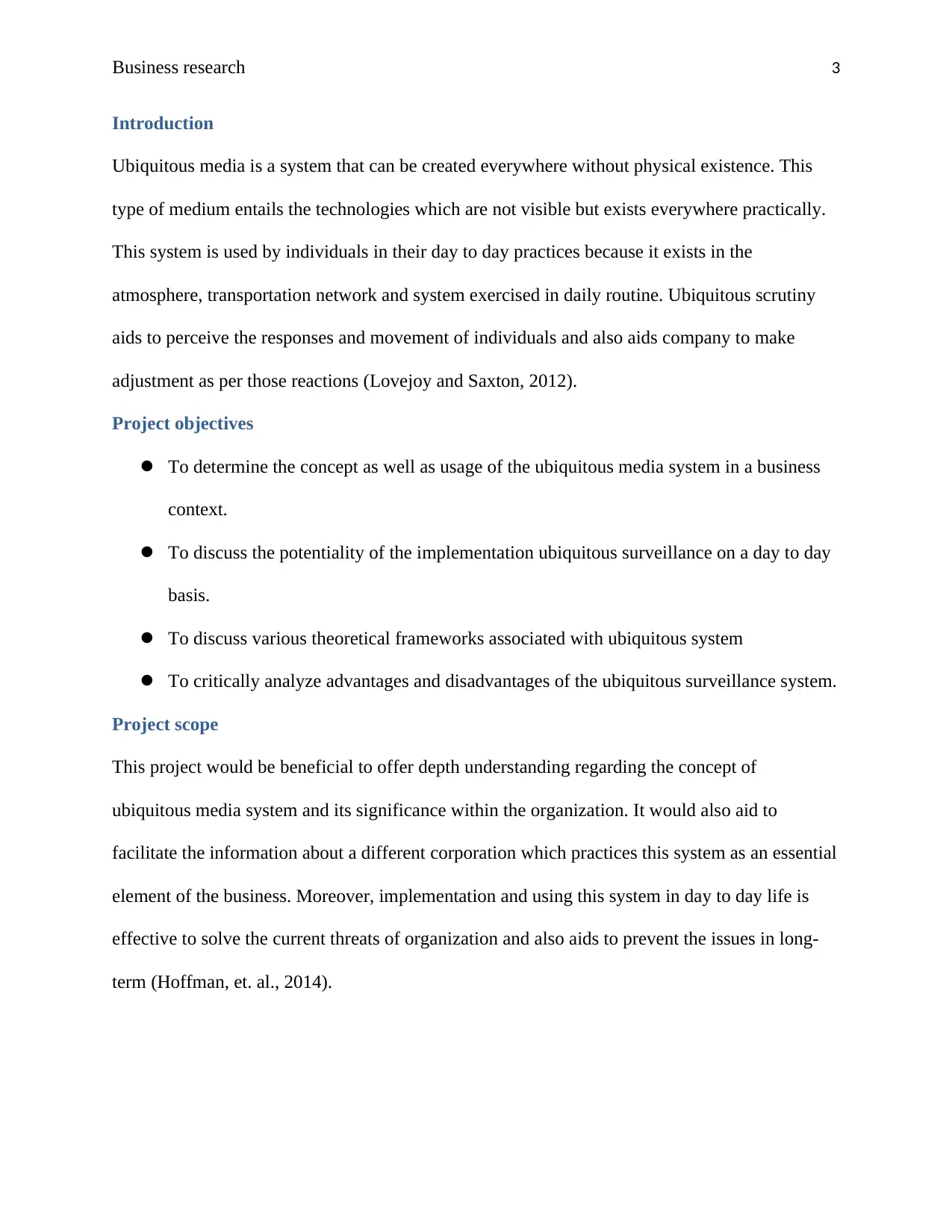
Business research 3
Introduction
Ubiquitous media is a system that can be created everywhere without physical existence. This
type of medium entails the technologies which are not visible but exists everywhere practically.
This system is used by individuals in their day to day practices because it exists in the
atmosphere, transportation network and system exercised in daily routine. Ubiquitous scrutiny
aids to perceive the responses and movement of individuals and also aids company to make
adjustment as per those reactions (Lovejoy and Saxton, 2012).
Project objectives
To determine the concept as well as usage of the ubiquitous media system in a business
context.
To discuss the potentiality of the implementation ubiquitous surveillance on a day to day
basis.
To discuss various theoretical frameworks associated with ubiquitous system
To critically analyze advantages and disadvantages of the ubiquitous surveillance system.
Project scope
This project would be beneficial to offer depth understanding regarding the concept of
ubiquitous media system and its significance within the organization. It would also aid to
facilitate the information about a different corporation which practices this system as an essential
element of the business. Moreover, implementation and using this system in day to day life is
effective to solve the current threats of organization and also aids to prevent the issues in long-
term (Hoffman, et. al., 2014).
Introduction
Ubiquitous media is a system that can be created everywhere without physical existence. This
type of medium entails the technologies which are not visible but exists everywhere practically.
This system is used by individuals in their day to day practices because it exists in the
atmosphere, transportation network and system exercised in daily routine. Ubiquitous scrutiny
aids to perceive the responses and movement of individuals and also aids company to make
adjustment as per those reactions (Lovejoy and Saxton, 2012).
Project objectives
To determine the concept as well as usage of the ubiquitous media system in a business
context.
To discuss the potentiality of the implementation ubiquitous surveillance on a day to day
basis.
To discuss various theoretical frameworks associated with ubiquitous system
To critically analyze advantages and disadvantages of the ubiquitous surveillance system.
Project scope
This project would be beneficial to offer depth understanding regarding the concept of
ubiquitous media system and its significance within the organization. It would also aid to
facilitate the information about a different corporation which practices this system as an essential
element of the business. Moreover, implementation and using this system in day to day life is
effective to solve the current threats of organization and also aids to prevent the issues in long-
term (Hoffman, et. al., 2014).
⊘ This is a preview!⊘
Do you want full access?
Subscribe today to unlock all pages.

Trusted by 1+ million students worldwide
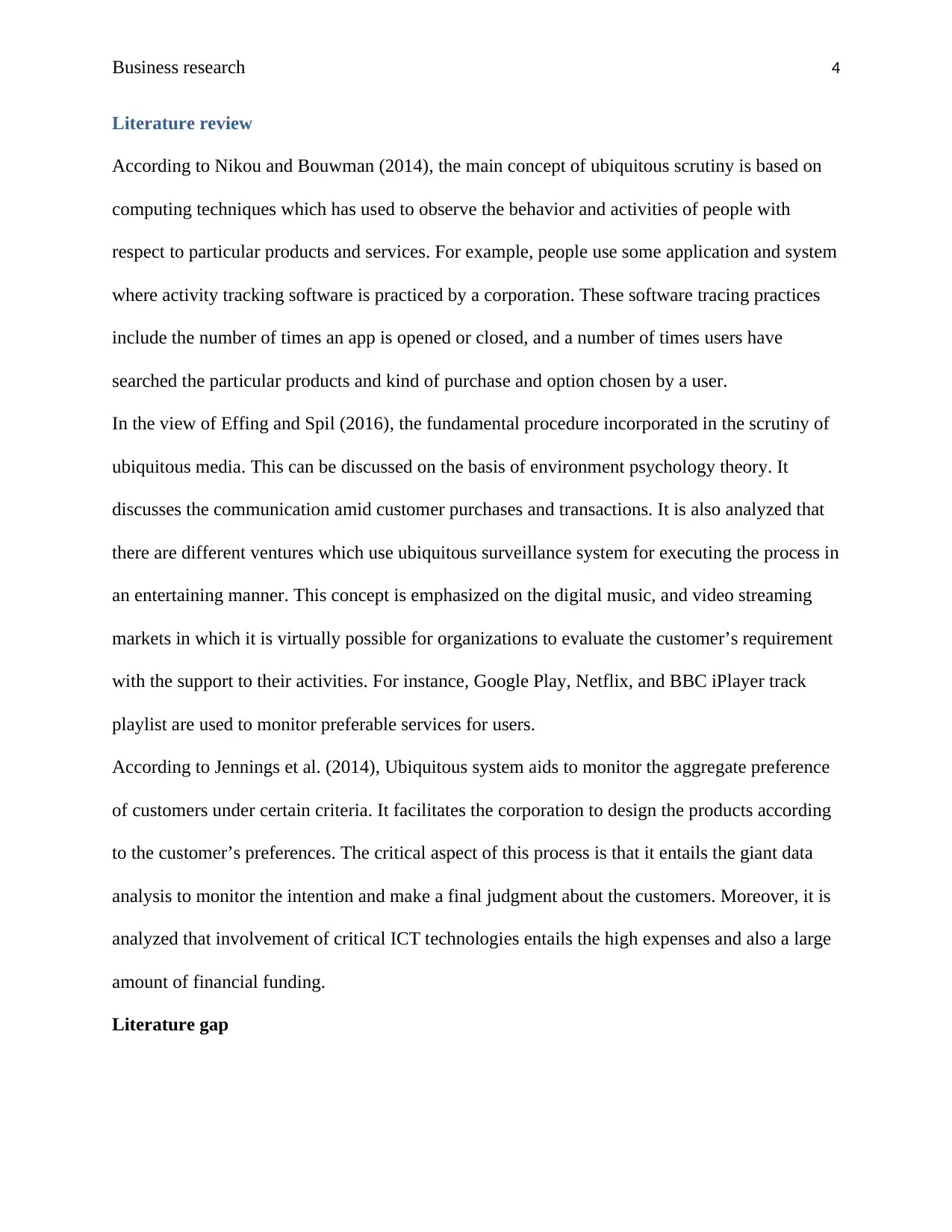
Business research 4
Literature review
According to Nikou and Bouwman (2014), the main concept of ubiquitous scrutiny is based on
computing techniques which has used to observe the behavior and activities of people with
respect to particular products and services. For example, people use some application and system
where activity tracking software is practiced by a corporation. These software tracing practices
include the number of times an app is opened or closed, and a number of times users have
searched the particular products and kind of purchase and option chosen by a user.
In the view of Effing and Spil (2016), the fundamental procedure incorporated in the scrutiny of
ubiquitous media. This can be discussed on the basis of environment psychology theory. It
discusses the communication amid customer purchases and transactions. It is also analyzed that
there are different ventures which use ubiquitous surveillance system for executing the process in
an entertaining manner. This concept is emphasized on the digital music, and video streaming
markets in which it is virtually possible for organizations to evaluate the customer’s requirement
with the support to their activities. For instance, Google Play, Netflix, and BBC iPlayer track
playlist are used to monitor preferable services for users.
According to Jennings et al. (2014), Ubiquitous system aids to monitor the aggregate preference
of customers under certain criteria. It facilitates the corporation to design the products according
to the customer’s preferences. The critical aspect of this process is that it entails the giant data
analysis to monitor the intention and make a final judgment about the customers. Moreover, it is
analyzed that involvement of critical ICT technologies entails the high expenses and also a large
amount of financial funding.
Literature gap
Literature review
According to Nikou and Bouwman (2014), the main concept of ubiquitous scrutiny is based on
computing techniques which has used to observe the behavior and activities of people with
respect to particular products and services. For example, people use some application and system
where activity tracking software is practiced by a corporation. These software tracing practices
include the number of times an app is opened or closed, and a number of times users have
searched the particular products and kind of purchase and option chosen by a user.
In the view of Effing and Spil (2016), the fundamental procedure incorporated in the scrutiny of
ubiquitous media. This can be discussed on the basis of environment psychology theory. It
discusses the communication amid customer purchases and transactions. It is also analyzed that
there are different ventures which use ubiquitous surveillance system for executing the process in
an entertaining manner. This concept is emphasized on the digital music, and video streaming
markets in which it is virtually possible for organizations to evaluate the customer’s requirement
with the support to their activities. For instance, Google Play, Netflix, and BBC iPlayer track
playlist are used to monitor preferable services for users.
According to Jennings et al. (2014), Ubiquitous system aids to monitor the aggregate preference
of customers under certain criteria. It facilitates the corporation to design the products according
to the customer’s preferences. The critical aspect of this process is that it entails the giant data
analysis to monitor the intention and make a final judgment about the customers. Moreover, it is
analyzed that involvement of critical ICT technologies entails the high expenses and also a large
amount of financial funding.
Literature gap
Paraphrase This Document
Need a fresh take? Get an instant paraphrase of this document with our AI Paraphraser
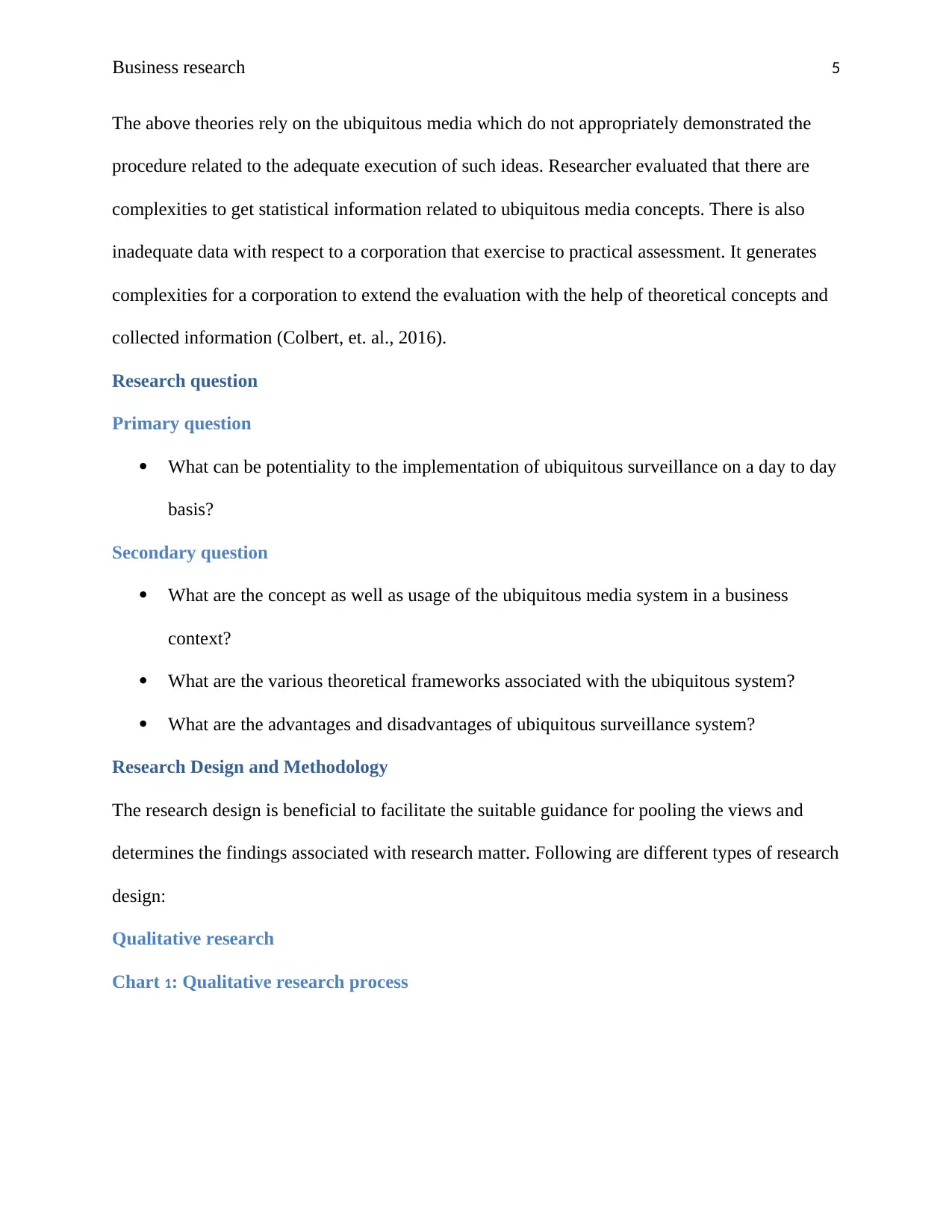
Business research 5
The above theories rely on the ubiquitous media which do not appropriately demonstrated the
procedure related to the adequate execution of such ideas. Researcher evaluated that there are
complexities to get statistical information related to ubiquitous media concepts. There is also
inadequate data with respect to a corporation that exercise to practical assessment. It generates
complexities for a corporation to extend the evaluation with the help of theoretical concepts and
collected information (Colbert, et. al., 2016).
Research question
Primary question
What can be potentiality to the implementation of ubiquitous surveillance on a day to day
basis?
Secondary question
What are the concept as well as usage of the ubiquitous media system in a business
context?
What are the various theoretical frameworks associated with the ubiquitous system?
What are the advantages and disadvantages of ubiquitous surveillance system?
Research Design and Methodology
The research design is beneficial to facilitate the suitable guidance for pooling the views and
determines the findings associated with research matter. Following are different types of research
design:
Qualitative research
Chart 1: Qualitative research process
The above theories rely on the ubiquitous media which do not appropriately demonstrated the
procedure related to the adequate execution of such ideas. Researcher evaluated that there are
complexities to get statistical information related to ubiquitous media concepts. There is also
inadequate data with respect to a corporation that exercise to practical assessment. It generates
complexities for a corporation to extend the evaluation with the help of theoretical concepts and
collected information (Colbert, et. al., 2016).
Research question
Primary question
What can be potentiality to the implementation of ubiquitous surveillance on a day to day
basis?
Secondary question
What are the concept as well as usage of the ubiquitous media system in a business
context?
What are the various theoretical frameworks associated with the ubiquitous system?
What are the advantages and disadvantages of ubiquitous surveillance system?
Research Design and Methodology
The research design is beneficial to facilitate the suitable guidance for pooling the views and
determines the findings associated with research matter. Following are different types of research
design:
Qualitative research
Chart 1: Qualitative research process
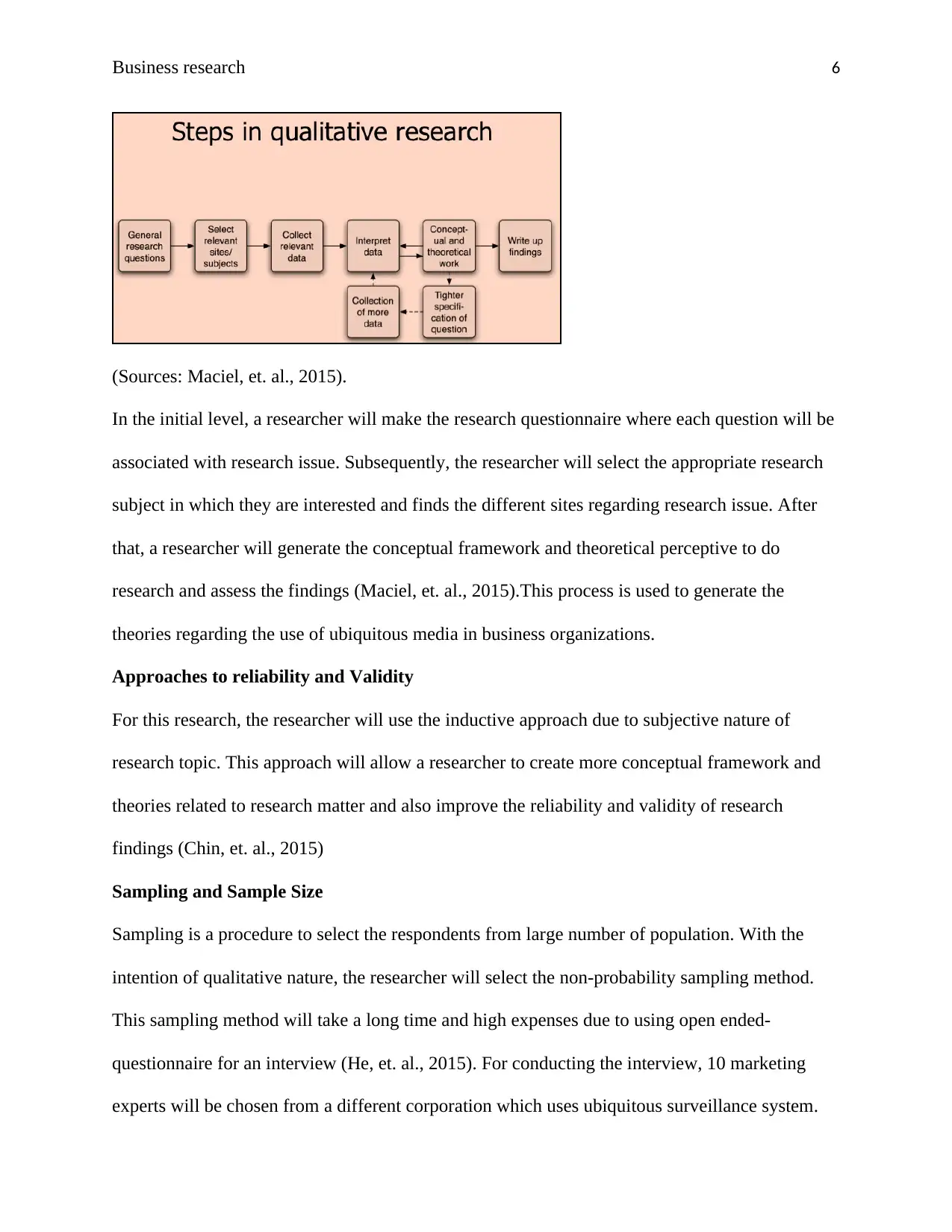
Business research 6
(Sources: Maciel, et. al., 2015).
In the initial level, a researcher will make the research questionnaire where each question will be
associated with research issue. Subsequently, the researcher will select the appropriate research
subject in which they are interested and finds the different sites regarding research issue. After
that, a researcher will generate the conceptual framework and theoretical perceptive to do
research and assess the findings (Maciel, et. al., 2015).This process is used to generate the
theories regarding the use of ubiquitous media in business organizations.
Approaches to reliability and Validity
For this research, the researcher will use the inductive approach due to subjective nature of
research topic. This approach will allow a researcher to create more conceptual framework and
theories related to research matter and also improve the reliability and validity of research
findings (Chin, et. al., 2015)
Sampling and Sample Size
Sampling is a procedure to select the respondents from large number of population. With the
intention of qualitative nature, the researcher will select the non-probability sampling method.
This sampling method will take a long time and high expenses due to using open ended-
questionnaire for an interview (He, et. al., 2015). For conducting the interview, 10 marketing
experts will be chosen from a different corporation which uses ubiquitous surveillance system.
(Sources: Maciel, et. al., 2015).
In the initial level, a researcher will make the research questionnaire where each question will be
associated with research issue. Subsequently, the researcher will select the appropriate research
subject in which they are interested and finds the different sites regarding research issue. After
that, a researcher will generate the conceptual framework and theoretical perceptive to do
research and assess the findings (Maciel, et. al., 2015).This process is used to generate the
theories regarding the use of ubiquitous media in business organizations.
Approaches to reliability and Validity
For this research, the researcher will use the inductive approach due to subjective nature of
research topic. This approach will allow a researcher to create more conceptual framework and
theories related to research matter and also improve the reliability and validity of research
findings (Chin, et. al., 2015)
Sampling and Sample Size
Sampling is a procedure to select the respondents from large number of population. With the
intention of qualitative nature, the researcher will select the non-probability sampling method.
This sampling method will take a long time and high expenses due to using open ended-
questionnaire for an interview (He, et. al., 2015). For conducting the interview, 10 marketing
experts will be chosen from a different corporation which uses ubiquitous surveillance system.
⊘ This is a preview!⊘
Do you want full access?
Subscribe today to unlock all pages.

Trusted by 1+ million students worldwide

Business research 7
Data Collection Method
For conducting this research, primary data collection method will be used a researcher. This data
will be collected from survey through questionnaire because it allows a researcher to pool a large
amount of information from specified participants. They deliver the fresh information about
research topic which would be effective to enhance the reliability and validity of outcome
(Stanko and Beckman, 2015).
Variables Specifications
With the purpose of this research, two kinds of variables will be used a researcher named
dependent and independent. Independent variable is the use of ubiquitous media and the
dependent variable is business practices of different companies (Väyrynen, et. al., 2013).
Quantitative research
Chart 2: Quantitative research process
(Sources: McFarland and Ployhart, 2015).
On the basis of above chart, it can be stated that a researcher will develop a theory and
hypothesis at the primary level. Afterward, a research will create the research design and
different aspects about research issue. Subsequently, a researcher will select appropriate sites and
suitable subject matter. After that, a researcher will pool the information and assess it through
Data Collection Method
For conducting this research, primary data collection method will be used a researcher. This data
will be collected from survey through questionnaire because it allows a researcher to pool a large
amount of information from specified participants. They deliver the fresh information about
research topic which would be effective to enhance the reliability and validity of outcome
(Stanko and Beckman, 2015).
Variables Specifications
With the purpose of this research, two kinds of variables will be used a researcher named
dependent and independent. Independent variable is the use of ubiquitous media and the
dependent variable is business practices of different companies (Väyrynen, et. al., 2013).
Quantitative research
Chart 2: Quantitative research process
(Sources: McFarland and Ployhart, 2015).
On the basis of above chart, it can be stated that a researcher will develop a theory and
hypothesis at the primary level. Afterward, a research will create the research design and
different aspects about research issue. Subsequently, a researcher will select appropriate sites and
suitable subject matter. After that, a researcher will pool the information and assess it through
Paraphrase This Document
Need a fresh take? Get an instant paraphrase of this document with our AI Paraphraser
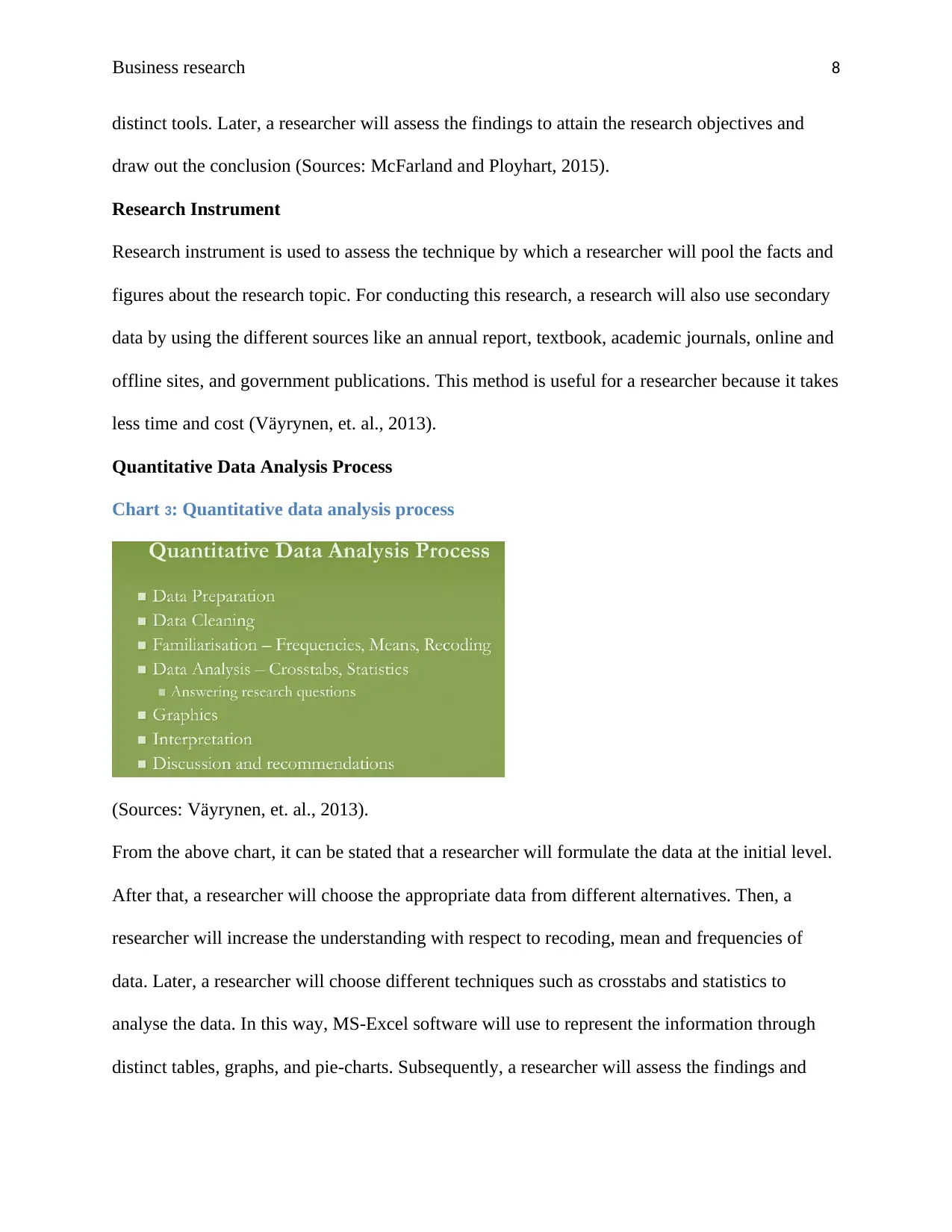
Business research 8
distinct tools. Later, a researcher will assess the findings to attain the research objectives and
draw out the conclusion (Sources: McFarland and Ployhart, 2015).
Research Instrument
Research instrument is used to assess the technique by which a researcher will pool the facts and
figures about the research topic. For conducting this research, a research will also use secondary
data by using the different sources like an annual report, textbook, academic journals, online and
offline sites, and government publications. This method is useful for a researcher because it takes
less time and cost (Väyrynen, et. al., 2013).
Quantitative Data Analysis Process
Chart 3: Quantitative data analysis process
(Sources: Väyrynen, et. al., 2013).
From the above chart, it can be stated that a researcher will formulate the data at the initial level.
After that, a researcher will choose the appropriate data from different alternatives. Then, a
researcher will increase the understanding with respect to recoding, mean and frequencies of
data. Later, a researcher will choose different techniques such as crosstabs and statistics to
analyse the data. In this way, MS-Excel software will use to represent the information through
distinct tables, graphs, and pie-charts. Subsequently, a researcher will assess the findings and
distinct tools. Later, a researcher will assess the findings to attain the research objectives and
draw out the conclusion (Sources: McFarland and Ployhart, 2015).
Research Instrument
Research instrument is used to assess the technique by which a researcher will pool the facts and
figures about the research topic. For conducting this research, a research will also use secondary
data by using the different sources like an annual report, textbook, academic journals, online and
offline sites, and government publications. This method is useful for a researcher because it takes
less time and cost (Väyrynen, et. al., 2013).
Quantitative Data Analysis Process
Chart 3: Quantitative data analysis process
(Sources: Väyrynen, et. al., 2013).
From the above chart, it can be stated that a researcher will formulate the data at the initial level.
After that, a researcher will choose the appropriate data from different alternatives. Then, a
researcher will increase the understanding with respect to recoding, mean and frequencies of
data. Later, a researcher will choose different techniques such as crosstabs and statistics to
analyse the data. In this way, MS-Excel software will use to represent the information through
distinct tables, graphs, and pie-charts. Subsequently, a researcher will assess the findings and
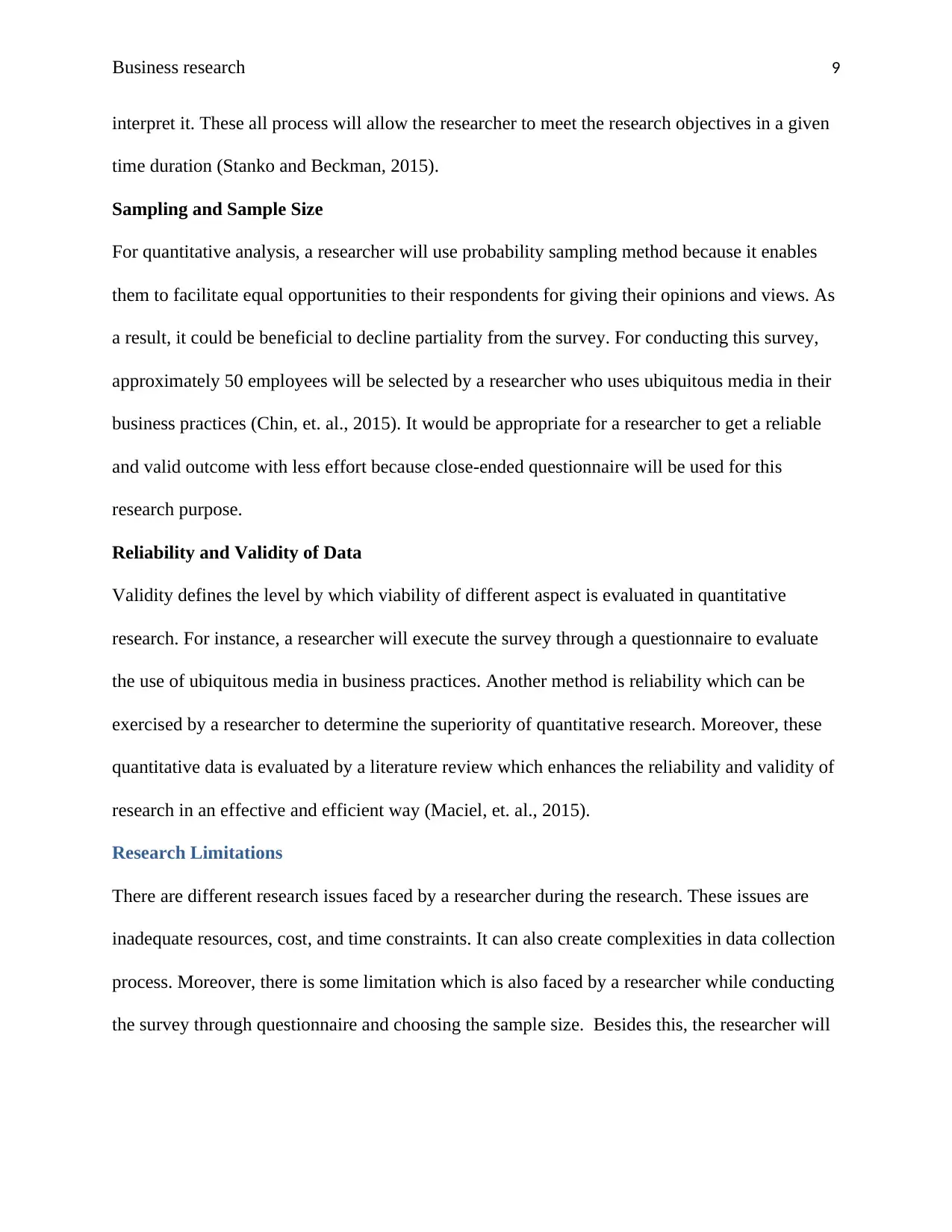
Business research 9
interpret it. These all process will allow the researcher to meet the research objectives in a given
time duration (Stanko and Beckman, 2015).
Sampling and Sample Size
For quantitative analysis, a researcher will use probability sampling method because it enables
them to facilitate equal opportunities to their respondents for giving their opinions and views. As
a result, it could be beneficial to decline partiality from the survey. For conducting this survey,
approximately 50 employees will be selected by a researcher who uses ubiquitous media in their
business practices (Chin, et. al., 2015). It would be appropriate for a researcher to get a reliable
and valid outcome with less effort because close-ended questionnaire will be used for this
research purpose.
Reliability and Validity of Data
Validity defines the level by which viability of different aspect is evaluated in quantitative
research. For instance, a researcher will execute the survey through a questionnaire to evaluate
the use of ubiquitous media in business practices. Another method is reliability which can be
exercised by a researcher to determine the superiority of quantitative research. Moreover, these
quantitative data is evaluated by a literature review which enhances the reliability and validity of
research in an effective and efficient way (Maciel, et. al., 2015).
Research Limitations
There are different research issues faced by a researcher during the research. These issues are
inadequate resources, cost, and time constraints. It can also create complexities in data collection
process. Moreover, there is some limitation which is also faced by a researcher while conducting
the survey through questionnaire and choosing the sample size. Besides this, the researcher will
interpret it. These all process will allow the researcher to meet the research objectives in a given
time duration (Stanko and Beckman, 2015).
Sampling and Sample Size
For quantitative analysis, a researcher will use probability sampling method because it enables
them to facilitate equal opportunities to their respondents for giving their opinions and views. As
a result, it could be beneficial to decline partiality from the survey. For conducting this survey,
approximately 50 employees will be selected by a researcher who uses ubiquitous media in their
business practices (Chin, et. al., 2015). It would be appropriate for a researcher to get a reliable
and valid outcome with less effort because close-ended questionnaire will be used for this
research purpose.
Reliability and Validity of Data
Validity defines the level by which viability of different aspect is evaluated in quantitative
research. For instance, a researcher will execute the survey through a questionnaire to evaluate
the use of ubiquitous media in business practices. Another method is reliability which can be
exercised by a researcher to determine the superiority of quantitative research. Moreover, these
quantitative data is evaluated by a literature review which enhances the reliability and validity of
research in an effective and efficient way (Maciel, et. al., 2015).
Research Limitations
There are different research issues faced by a researcher during the research. These issues are
inadequate resources, cost, and time constraints. It can also create complexities in data collection
process. Moreover, there is some limitation which is also faced by a researcher while conducting
the survey through questionnaire and choosing the sample size. Besides this, the researcher will
⊘ This is a preview!⊘
Do you want full access?
Subscribe today to unlock all pages.

Trusted by 1+ million students worldwide
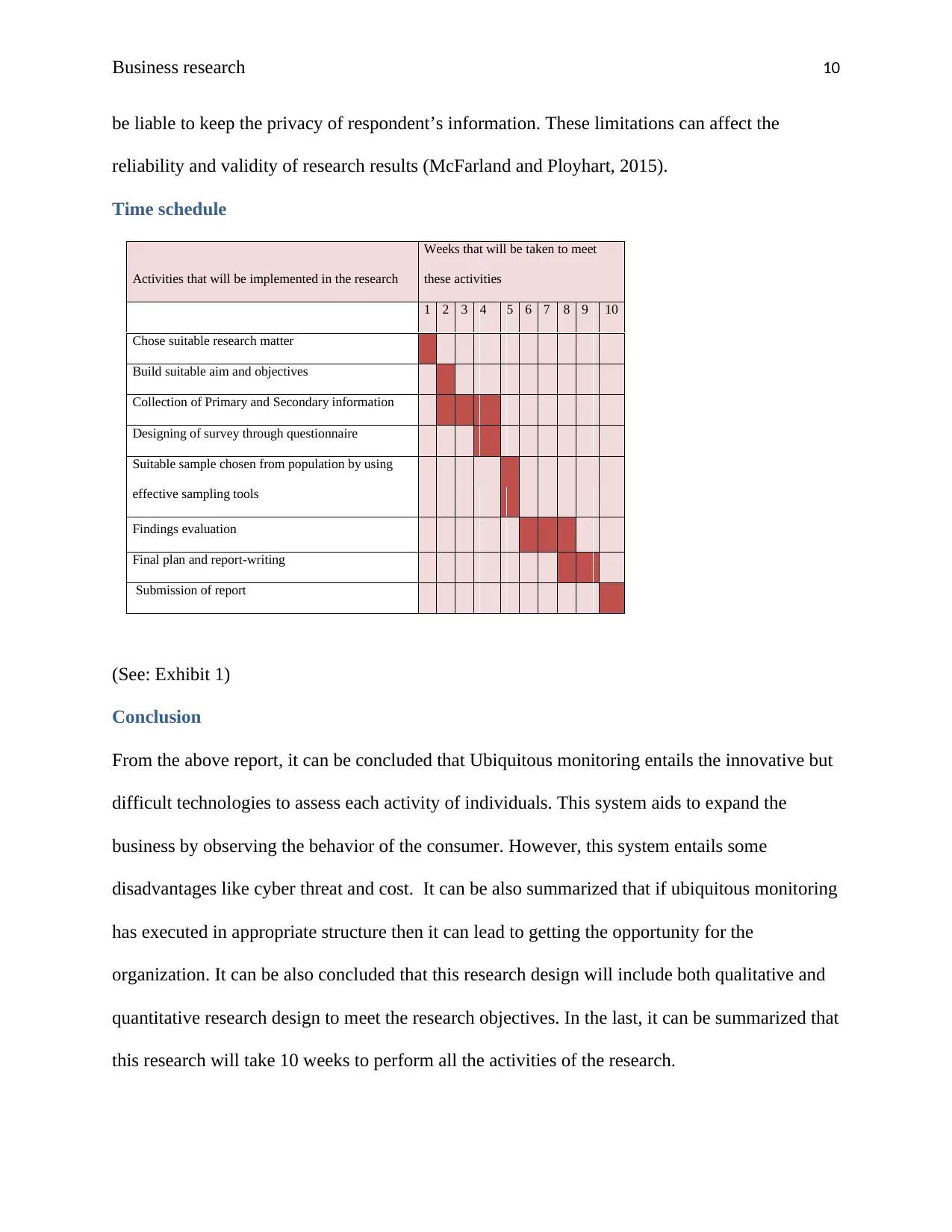
Business research 10
be liable to keep the privacy of respondent’s information. These limitations can affect the
reliability and validity of research results (McFarland and Ployhart, 2015).
Time schedule
Activities that will be implemented in the research
Weeks that will be taken to meet
these activities
1 2 3 4 5 6 7 8 9 10
Chose suitable research matter
Build suitable aim and objectives
Collection of Primary and Secondary information
Designing of survey through questionnaire
Suitable sample chosen from population by using
effective sampling tools
Findings evaluation
Final plan and report-writing
Submission of report
(See: Exhibit 1)
Conclusion
From the above report, it can be concluded that Ubiquitous monitoring entails the innovative but
difficult technologies to assess each activity of individuals. This system aids to expand the
business by observing the behavior of the consumer. However, this system entails some
disadvantages like cyber threat and cost. It can be also summarized that if ubiquitous monitoring
has executed in appropriate structure then it can lead to getting the opportunity for the
organization. It can be also concluded that this research design will include both qualitative and
quantitative research design to meet the research objectives. In the last, it can be summarized that
this research will take 10 weeks to perform all the activities of the research.
be liable to keep the privacy of respondent’s information. These limitations can affect the
reliability and validity of research results (McFarland and Ployhart, 2015).
Time schedule
Activities that will be implemented in the research
Weeks that will be taken to meet
these activities
1 2 3 4 5 6 7 8 9 10
Chose suitable research matter
Build suitable aim and objectives
Collection of Primary and Secondary information
Designing of survey through questionnaire
Suitable sample chosen from population by using
effective sampling tools
Findings evaluation
Final plan and report-writing
Submission of report
(See: Exhibit 1)
Conclusion
From the above report, it can be concluded that Ubiquitous monitoring entails the innovative but
difficult technologies to assess each activity of individuals. This system aids to expand the
business by observing the behavior of the consumer. However, this system entails some
disadvantages like cyber threat and cost. It can be also summarized that if ubiquitous monitoring
has executed in appropriate structure then it can lead to getting the opportunity for the
organization. It can be also concluded that this research design will include both qualitative and
quantitative research design to meet the research objectives. In the last, it can be summarized that
this research will take 10 weeks to perform all the activities of the research.
Paraphrase This Document
Need a fresh take? Get an instant paraphrase of this document with our AI Paraphraser
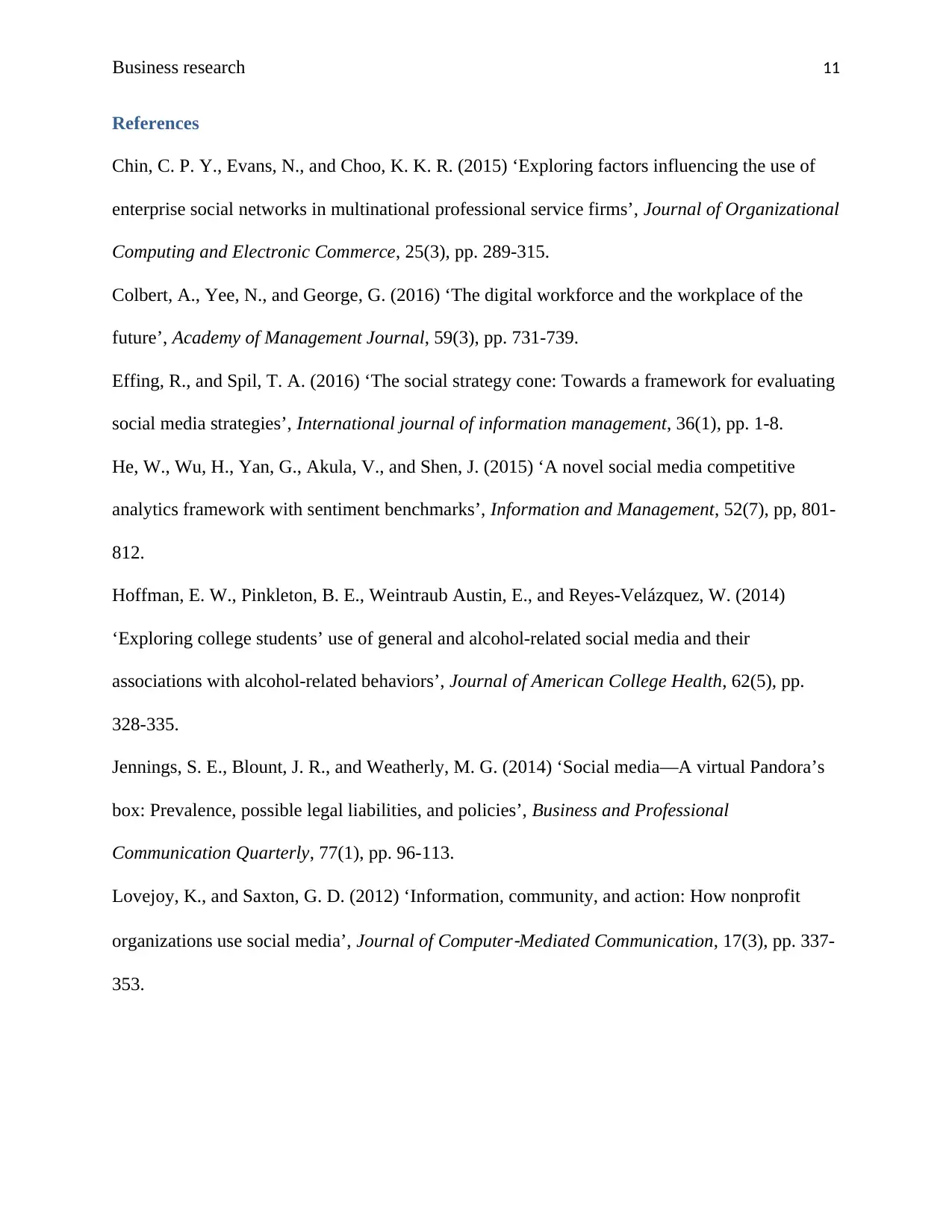
Business research 11
References
Chin, C. P. Y., Evans, N., and Choo, K. K. R. (2015) ‘Exploring factors influencing the use of
enterprise social networks in multinational professional service firms’, Journal of Organizational
Computing and Electronic Commerce, 25(3), pp. 289-315.
Colbert, A., Yee, N., and George, G. (2016) ‘The digital workforce and the workplace of the
future’, Academy of Management Journal, 59(3), pp. 731-739.
Effing, R., and Spil, T. A. (2016) ‘The social strategy cone: Towards a framework for evaluating
social media strategies’, International journal of information management, 36(1), pp. 1-8.
He, W., Wu, H., Yan, G., Akula, V., and Shen, J. (2015) ‘A novel social media competitive
analytics framework with sentiment benchmarks’, Information and Management, 52(7), pp, 801-
812.
Hoffman, E. W., Pinkleton, B. E., Weintraub Austin, E., and Reyes-Velázquez, W. (2014)
‘Exploring college students’ use of general and alcohol-related social media and their
associations with alcohol-related behaviors’, Journal of American College Health, 62(5), pp.
328-335.
Jennings, S. E., Blount, J. R., and Weatherly, M. G. (2014) ‘Social media—A virtual Pandora’s
box: Prevalence, possible legal liabilities, and policies’, Business and Professional
Communication Quarterly, 77(1), pp. 96-113.
Lovejoy, K., and Saxton, G. D. (2012) ‘Information, community, and action: How nonprofit
organizations use social media’, Journal of Computer
‐Mediated Communication, 17(3), pp. 337-
353.
References
Chin, C. P. Y., Evans, N., and Choo, K. K. R. (2015) ‘Exploring factors influencing the use of
enterprise social networks in multinational professional service firms’, Journal of Organizational
Computing and Electronic Commerce, 25(3), pp. 289-315.
Colbert, A., Yee, N., and George, G. (2016) ‘The digital workforce and the workplace of the
future’, Academy of Management Journal, 59(3), pp. 731-739.
Effing, R., and Spil, T. A. (2016) ‘The social strategy cone: Towards a framework for evaluating
social media strategies’, International journal of information management, 36(1), pp. 1-8.
He, W., Wu, H., Yan, G., Akula, V., and Shen, J. (2015) ‘A novel social media competitive
analytics framework with sentiment benchmarks’, Information and Management, 52(7), pp, 801-
812.
Hoffman, E. W., Pinkleton, B. E., Weintraub Austin, E., and Reyes-Velázquez, W. (2014)
‘Exploring college students’ use of general and alcohol-related social media and their
associations with alcohol-related behaviors’, Journal of American College Health, 62(5), pp.
328-335.
Jennings, S. E., Blount, J. R., and Weatherly, M. G. (2014) ‘Social media—A virtual Pandora’s
box: Prevalence, possible legal liabilities, and policies’, Business and Professional
Communication Quarterly, 77(1), pp. 96-113.
Lovejoy, K., and Saxton, G. D. (2012) ‘Information, community, and action: How nonprofit
organizations use social media’, Journal of Computer
‐Mediated Communication, 17(3), pp. 337-
353.
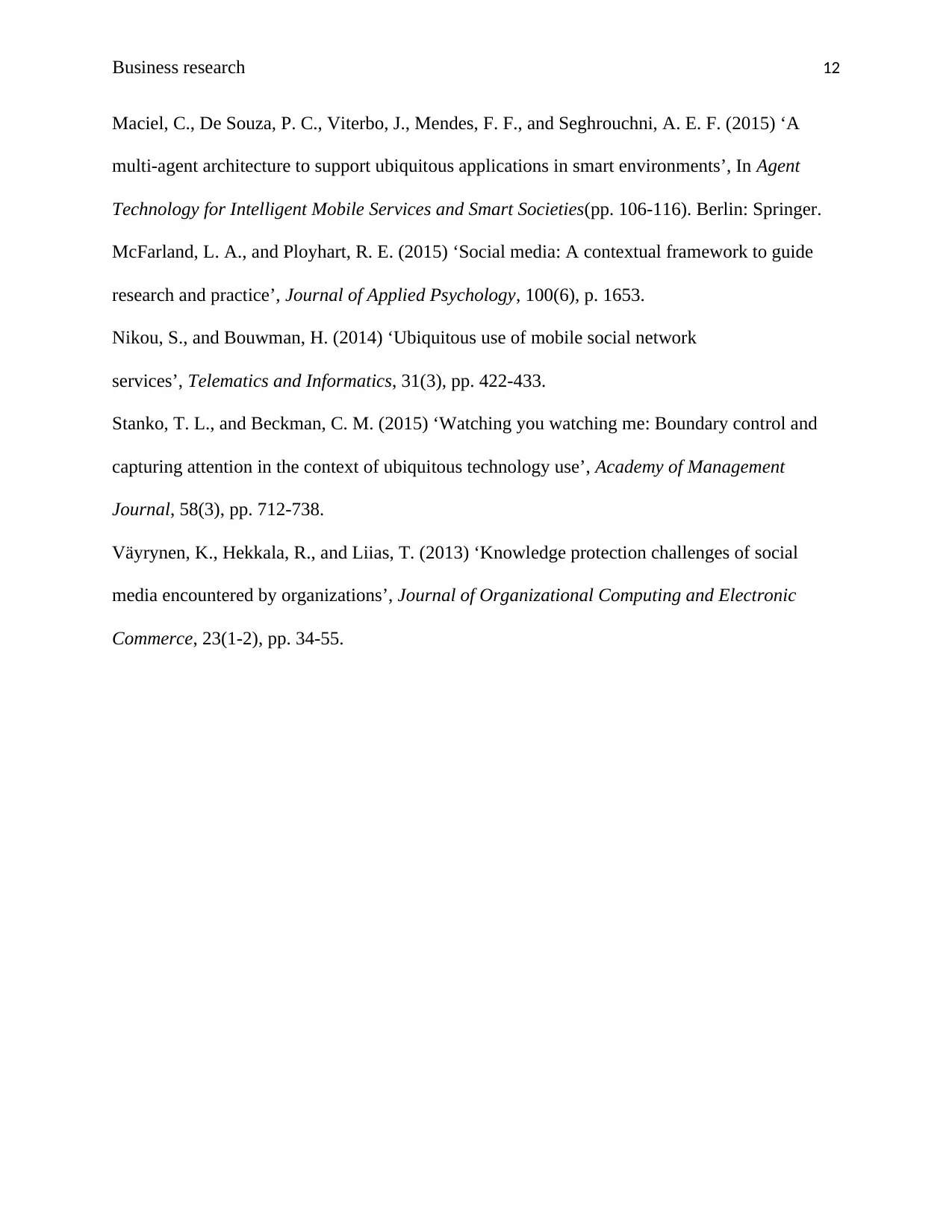
Business research 12
Maciel, C., De Souza, P. C., Viterbo, J., Mendes, F. F., and Seghrouchni, A. E. F. (2015) ‘A
multi-agent architecture to support ubiquitous applications in smart environments’, In Agent
Technology for Intelligent Mobile Services and Smart Societies(pp. 106-116). Berlin: Springer.
McFarland, L. A., and Ployhart, R. E. (2015) ‘Social media: A contextual framework to guide
research and practice’, Journal of Applied Psychology, 100(6), p. 1653.
Nikou, S., and Bouwman, H. (2014) ‘Ubiquitous use of mobile social network
services’, Telematics and Informatics, 31(3), pp. 422-433.
Stanko, T. L., and Beckman, C. M. (2015) ‘Watching you watching me: Boundary control and
capturing attention in the context of ubiquitous technology use’, Academy of Management
Journal, 58(3), pp. 712-738.
Väyrynen, K., Hekkala, R., and Liias, T. (2013) ‘Knowledge protection challenges of social
media encountered by organizations’, Journal of Organizational Computing and Electronic
Commerce, 23(1-2), pp. 34-55.
Maciel, C., De Souza, P. C., Viterbo, J., Mendes, F. F., and Seghrouchni, A. E. F. (2015) ‘A
multi-agent architecture to support ubiquitous applications in smart environments’, In Agent
Technology for Intelligent Mobile Services and Smart Societies(pp. 106-116). Berlin: Springer.
McFarland, L. A., and Ployhart, R. E. (2015) ‘Social media: A contextual framework to guide
research and practice’, Journal of Applied Psychology, 100(6), p. 1653.
Nikou, S., and Bouwman, H. (2014) ‘Ubiquitous use of mobile social network
services’, Telematics and Informatics, 31(3), pp. 422-433.
Stanko, T. L., and Beckman, C. M. (2015) ‘Watching you watching me: Boundary control and
capturing attention in the context of ubiquitous technology use’, Academy of Management
Journal, 58(3), pp. 712-738.
Väyrynen, K., Hekkala, R., and Liias, T. (2013) ‘Knowledge protection challenges of social
media encountered by organizations’, Journal of Organizational Computing and Electronic
Commerce, 23(1-2), pp. 34-55.
⊘ This is a preview!⊘
Do you want full access?
Subscribe today to unlock all pages.

Trusted by 1+ million students worldwide
1 out of 13
Related Documents
Your All-in-One AI-Powered Toolkit for Academic Success.
+13062052269
info@desklib.com
Available 24*7 on WhatsApp / Email
![[object Object]](/_next/static/media/star-bottom.7253800d.svg)
Unlock your academic potential
Copyright © 2020–2025 A2Z Services. All Rights Reserved. Developed and managed by ZUCOL.





